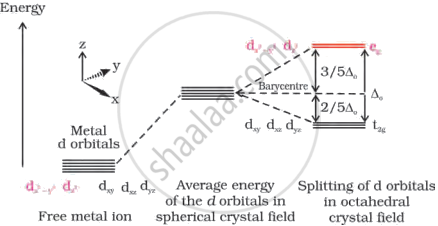Advertisements
Advertisements
Question
Draw figure to show the splitting of d orbitals in an octahedral crystal field.
Solution
Let the six ligands be symmetrically located along the Cartesian axes and the metal atom is at the origin.
On approaching the ligand, the energy of the d-orbitals increases as expected compared to the free ions. As is the case in a spherical crystal field.
The orbitals along the axes (`d_(Z^2)` and `d_(x^2 - y^2)`) repel more strongly than the dxy, dyz and dzx orbitals and have lobes directed between the axes. In the spherical crystal field, the `d_(Z^2)` and `d_(x^2 - y^2)` orbitals increase in energy and the dxy, dyz, dzx orbitals decrease in energy compared to the average energy.
Therefore, the degenerate set of d-orbitals splits into two groups – the low energy orbital group t2g and the high energy orbital group eg separated by energy Δ0.

d orbital splitting in an octahedral crystal field
APPEARS IN
RELATED QUESTIONS
The hexaquo manganese (II) ion contains five unpaired electrons, while the hexacyanoion contains only one unpaired electron. Explain using Crystal Field Theory.
Why are low spin tetrahedral complexes rarely observed?
The CFSE for octahedral \[\ce{[CoCl6]^{4-}}\] is 18,000 cm–1. The CFSE for tetrahedral \[\ce{[CoCl4]^{2-}}\] will be ______.
Atomic number of \[\ce{Mn}\], \[\ce{Fe}\] and \[\ce{Co}\] are 25, 26 and 27 respectively. Which of the following inner orbital octahedral complex ions are diamagnetic?
(i) \[\ce{[Co(NH3)6]^{3+}}\]
(ii) \[\ce{[Mn(CN)6]^{3-}}\]
(iii) \[\ce{[Fe(CN)6]^{4-}}\]
(iv) \[\ce{[Fe(CN)6]^{3-}}\]
An aqueous pink solution of cobalt (II) chloride changes to deep blue on addition of excess of HCl. This is because:
(i) \[\ce{[Co(H2O)6]^{2+}}\] is transformed into \[\ce{[CoCl6]}^{4-}\]
(ii) \[\ce{[Co(H2O)6]^{2+}}\] is transformed into \[\ce{[CoCl4]}^{2-}\]
(iii) tetrahedral complexes have smaller crystal field splitting than octahedral complexes.
(iv) tetrahedral complexes have larger crystal field splitting than octahedral complex.
Why are low spin tetrahedral complexes not formed?
\[\ce{CuSO4 . 5H2O}\] is blue in colour while \[\ce{CuSO4}\] is colourless. Why?
Match the complex ions given in Column I with the hybridisation and number of unpaired electrons given in Column II and assign the correct code:
| Column I (Complex ion) | Column II (Hybridisation, number of unpaired electrons) |
| A. \[\ce{[Cr(H2O)6]^{3+}}\] | 1. dsp2, 1 |
| B. \[\ce{[Co(CN)4]^{2-}}\] | 2. sp3d2, 5 |
| C. \[\ce{[Ni(NH3)6]^{2+}}\] | 3. d2sp3, 3 |
| D. \[\ce{[MnF6]^{4-}}\] | 4. sp3, 4 |
| 5. sp3d2, 2 |
Why are different colours observed in octahedral and tetrahedral complexes for the same metal and same ligands?
[Ni(H2O)6]2+ (aq) is green in colour whereas [Ni(H2O)4 (en)]2+ (aq)is blue in colour, give reason in support of your answer.
In a coordination entity, the electronic configuration of the central metal ion is t2g3 eg1
Draw the crystal field splitting diagram for the above complex.
The correct order of increasing crystal field strength in following series:
What is the spectrochemical series?
What is the difference between a weak field ligand and a strong field ligand?
The correct order of intensity of colors of the compounds is ______.
The complex that has highest crystal field splitting energy (Δ) is ______.
On the basis of Crystal Field theory, write the electronic configuration for the d5 ion with a strong field ligand for which Δ0 > P.
On the basis of crystal field theory, write the electronic configuration for d4 with a strong field ligand for which Δ0 > P.
